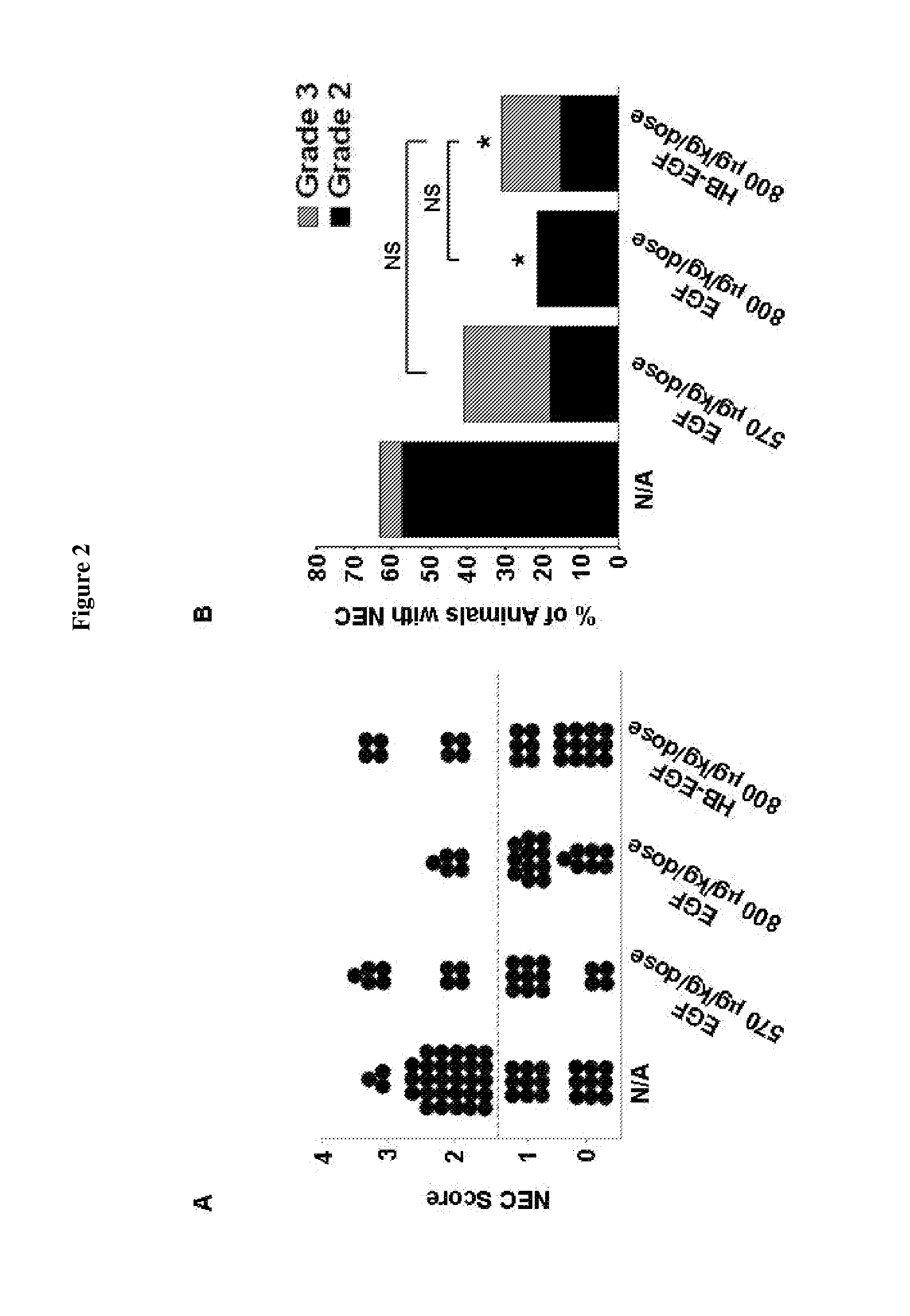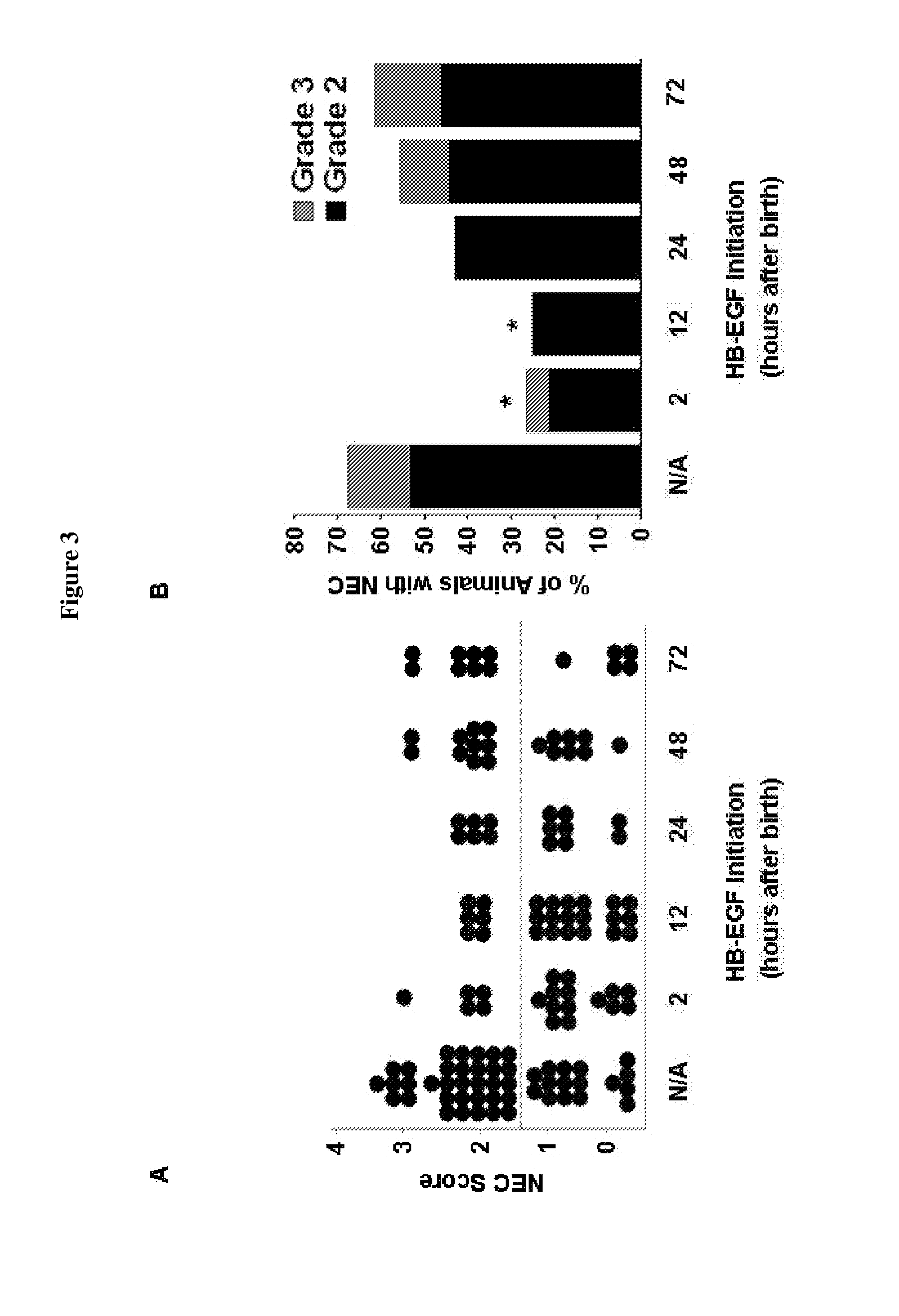Methods of treating necrotizing enterocolitis using heparin binding epidermal growth factor (hb-egf)
a technology of epidermal growth factor and necrotizing enterocolitis, which is applied in the direction of peptides, drug compositions, peptides, etc., can solve the problems of death, multiple organ dysfunction syndrome (mods), and patents that include no experimental data supporting such projections, and models of this type are useless for evaluating the recovery from intestinal ischemia. , to achieve the effect of enhancing regenerative capacity, facilitating maturation, and reducing intestinal injury
- Summary
- Abstract
- Description
- Claims
- Application Information
AI Technical Summary
Benefits of technology
Problems solved by technology
Method used
Image
Examples
example 1
Neonatal Rat Model of Experimental Necrotizing Enterocolitis
[0062]The studies described herein utilize a neonatal rat model of experimental NEC. These experimental protocols were performed according to the guidelines for the ethical treatment of experimental animals and approved by the Institutional Animal Care and Use Committee of Nationwide Children's Hospital (#04203AR). Necrotizing enterocolitis was induced using a modification of the neonatal rat model of NEC initially described by Barlow et al. (J Pediatr Surg 9:587-95, 1974). Pregnant time-dated Sprague-Dawley rats (Harlan Sprague-Dawley, Indianapolis, Ind.) were delivered by C-section under CO2 anesthesia on day 21.5 of gestation. Newborn rats were placed in a neonatal incubator for temperature control. Neonatal rats were fed via gavage with a formula containing 15 g Similac 60 / 40 (Ross Pediatrics, Columbus, Ohio) in 75 mL Esbilac (Pet-Ag, New Hampshire, Ill.), a diet that provided 836.8 kJ / kg per day. Feeds were started at ...
example 2
Dosing Interval of HB-EGF Administration
[0066]Enteral administration of HB-EGF at doses of 600 or 800 μg / kg / dose administered six times a day is known to significantly decrease the incidence and severity of experimental NEC (Feng et al., Pediatr Surg 41:144-149, 2006). It was of interest to investigate whether administration fewer than six times a day could also protect the intestines from NEC. In particular, the effect of decreasing HB-EGF dosing intervals was investigated.
[0067]Using the neonatal rat model of NEC, as described in Example 1, 203 newborn rat pups were randomized to receive HB-EGF added to their feeds two (BID), three (TID), four (QID) or six (HID) equally spaced times a day. Animals subjected to stress had a 63% incidence of NEC, with histopathologic changes in the intestines ranging from moderate, mid-level villous necrosis (grade 2) to severe necrosis of the entire villous (grade 3 and grade 4) (FIG. 1A, B). Rat pups that received HB-EGF (800 μg / kg / dose) added to ...
example 3
Comparison of P. pastoris-Derived and E. coli-Derived HB-EGF
[0068]To compare the efficacy of E. coli-derived and P. pastoris-derived HB-EGF, 199 rat pups were randomized to receive 600, 800 or 1000 μg / kg / dose of each type of HB-EGF added to their feeds 4 or 6 times a day using the neonatal rat model of NEC as described in Example 1. The HB-EGF used in all experiments was GMP grade human mature HB-EGF produced in P. pastoris yeast (KBI BioPharma, Inc., Durham, N.C.). E. coli-derived recombinant human mature HB-EGF produced as previously described (Davis et al., Protein Expr Purif 8:57-67, 1996) was used. Previous studies of the ability of E. coli-derived HB-EGF to prevent NEC tested doses up to but not exceeding 800 μg / kg / dose. Thus, the effect of increasing the dose of HB-EGF to 1000 μg / kg / dose was also tested. In this experiment, the incidence of NEC in stressed pups was 68%. When tested at doses of 600, 800, or 1000 μg / kg / dose, and dosing intervals of 4 or 6 times a day, there wer...
PUM
| Property | Measurement | Unit |
|---|---|---|
| Time | aaaaa | aaaaa |
| Time | aaaaa | aaaaa |
| Time | aaaaa | aaaaa |
Abstract
Description
Claims
Application Information
 Login to View More
Login to View More - R&D
- Intellectual Property
- Life Sciences
- Materials
- Tech Scout
- Unparalleled Data Quality
- Higher Quality Content
- 60% Fewer Hallucinations
Browse by: Latest US Patents, China's latest patents, Technical Efficacy Thesaurus, Application Domain, Technology Topic, Popular Technical Reports.
© 2025 PatSnap. All rights reserved.Legal|Privacy policy|Modern Slavery Act Transparency Statement|Sitemap|About US| Contact US: help@patsnap.com



